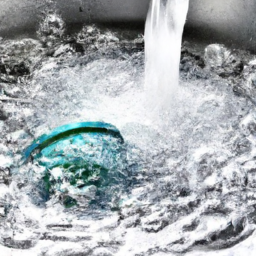Are reverse osmosis water filters Worth It? If you’re concerned about the quality of your drinking water, a reverse osmosis water filter might be just what you need. These filters use a semi-permeable membrane to remove impurities and contaminants, producing clear and purified water. The process involves pre-filtration, reverse osmosis, post-filtration, and storage, ensuring the highest level of purification. While the system does produce waste water, the benefits of having access to clean and safe drinking water on demand make the investment worth it for many. So, if you’re looking for a reliable and effective water filtration method, reverse osmosis might be the answer.
Pre-filtration
Before the water goes through the main reverse osmosis (RO) membrane, it first undergoes a pre-filtration stage. This stage plays a crucial role in removing larger particles and chemicals that could potentially harm the RO membrane and affect the overall effectiveness of the filtration process.
Sediment filter
The first component of the pre-filtration stage is the sediment filter. This filter is responsible for trapping larger particles like sand, silt, and sediment that may be present in the water. By removing these larger particles, the sediment filter helps to prevent clogging and damage to the delicate RO membrane, ensuring its longevity and performance.
Carbon filter
The second component of the pre-filtration stage is the carbon filter. This filter is designed to remove chlorine and other chemicals from the water. Chlorine, commonly used as a disinfectant in municipal water supplies, can negatively affect the performance and lifespan of the RO membrane. By removing chlorine and other chemicals, the carbon filter helps to safeguard the RO membrane and ensure optimal filtration results.
Reverse Osmosis
Once the water has passed through the pre-filtration stage, it enters the main reverse osmosis process. This process is the heart of the RO water filter system and is responsible for the actual purification of the water.
RO membrane
The reverse osmosis membrane is a crucial component that separates impurities and contaminants from the water. This semi-permeable membrane allows only water molecules to pass through, while trapping larger molecules such as salts, heavy metals, bacteria, and other harmful substances. The RO membrane effectively removes a wide range of contaminants, producing clear and purified water.
Post-filtration
After the reverse osmosis process, the water typically undergoes another filtration stage known as post-filtration. This stage further enhances the taste, odor, and overall quality of the purified water.
Carbon filter
The carbon filter, which is part of the post-filtration stage, helps to eliminate any lingering taste or odor in the purified water. This final step ensures that the water from the RO system is not only free from contaminants but also pleasant to drink.
Storage
Due to the relatively slow process of reverse osmosis filtration, the purified water is stored in a tank. This storage tank ensures that you have a readily available supply of purified water whenever you need it. The size of the tank may vary depending on the specific RO system, but it is an essential component for convenient access to clean water.
Drain or Waste
During the reverse osmosis process, there is a certain amount of water that is not converted into purified water. This water, known as brine or waste water, contains the concentrated contaminants that were removed during the filtration process. The waste water is typically flushed away to prevent it from mixing with the purified water. Some modern RO systems are designed with water-saving features that minimize the amount of waste water produced.
Faucet Delivery
To access the purified water, most RO systems include a dedicated faucet. When you turn on this faucet, the water is drawn from the storage tank, ensuring that you receive clean and filtered water for drinking, cooking, or any other purpose.
Summary
In summary, a reverse osmosis water filter is a highly effective water purification system that utilizes a semi-permeable membrane to remove impurities and contaminants. The filtration process involves pre-filtration to remove larger particles and chemicals, reverse osmosis to trap contaminants, and post-filtration to enhance the taste and odor of the purified water. The purified water is stored in a tank for convenient access, and any waste water is directed to a drain. With its comprehensive purification capabilities, a reverse osmosis water filter ensures that you have access to clean, clear, and great-tasting water whenever you need it.
Are Reverse Osmosis Water Filters Worth It
Now that you have a better understanding of how reverse osmosis water filters work, you may wonder if they are worth the investment. The answer depends on your specific needs and preferences.
Reverse osmosis water filters are particularly beneficial for individuals who live in areas with poor water quality or have specific health concerns regarding contaminants in their water supply. These filters are highly effective at removing a wide range of impurities, including chemicals, heavy metals, bacteria, and viruses. By investing in a reverse osmosis water filter, you can have peace of mind knowing that you and your family are consuming clean, purified water.
Additionally, reverse osmosis water filters can greatly improve the taste and odor of your water, making it more enjoyable to drink and cook with. If you have been experiencing unpleasant tastes or odors in your tap water, a reverse osmosis system can help address these concerns.
Furthermore, reverse osmosis water filters are easy to maintain. With regular filter replacements and simple maintenance tasks, such as tank sanitization, you can ensure that your system continues to deliver high-quality, purified water.
It’s important to note that while reverse osmosis water filters provide exceptional filtration, they may remove some beneficial minerals present in the water. However, it’s worth considering that these minerals can also be obtained through a balanced diet, and the health benefits of consuming purified water outweigh the loss of these minerals.
In conclusion, reverse osmosis water filters are a valuable investment for those who prioritize clean water and want to improve the overall quality, taste, and safety of their drinking water. With their comprehensive filtration capabilities and ease of maintenance, reverse osmosis water filters offer a convenient and reliable solution for obtaining clean and purified water at home.

